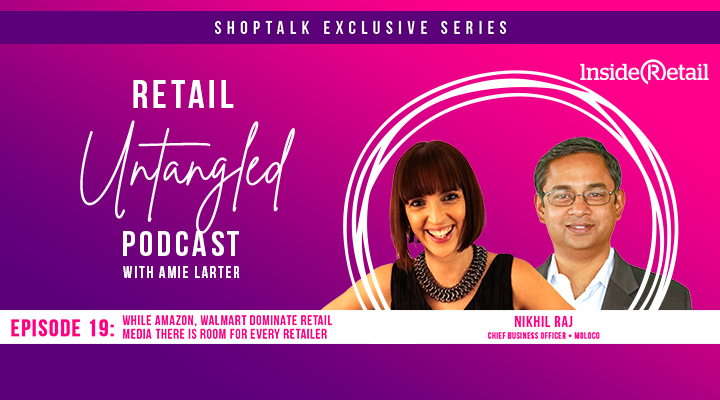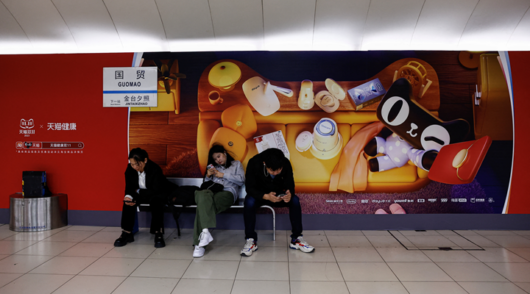Retail media has emerged as a significant revenue source for major brands like Walmart and Amazon – so why are smaller retailers missing out on the boom?
The answer is complicated, as Nikhil Raj, chief business officer, retail media, at Moloco, told Inside Retail’s Amie Larter during an episode of the Retail Untangled podcast recorded at Shoptalk Fall in Chicago. Moloco develops machine-learning solutions that unlock the value of first-party data.
Raj has 15 years in retail media. He started with the Walmart ads business, Walmart Exchange, the predecessor of Walmart Connect, and launched and scaled the global retail media practice at Bain & Co.
When Raj was building Walmart Exchange, there was very little revenue in the retailer’s advertising business, but last year, it accounted for $4 billion in turnover. However, that figure is dwarfed by Amazon, which takes in $50 billion in advertising revenue, with the business unit accounting for 68 per cent of the company’s overall profit. Its retail media returns have reached such dizzying heights because it serves ads on its own site, so it doesn’t have to pay a third party to serve the ad – or any commission on sales.
Walmart Exchange started after one of the largest advertisers in the world – Procter and Gamble, a Walmart vendor – wanted to understand the impact on store sales of the media it was buying. The company asked for a report on their advertising.
“So we started by giving them a little insight into the shoppers that were exposed to the media they were buying, and the impact of sales, which really was not available anywhere else, even today,” recalls Raj. “If you want sales data from Facebook or Google or someone else, you can’t get it unless the retailers share their data with those platforms so that fundamental difference of knowing who saw the impression and who bought the product is what makes retail media so unique.”
With the data unlocked and technologies like cloud, AI and machine learning deployed, advertisers have begun paying more attention to retail media, driving what Raj describes as “an explosion” during the past few years.
Raj says two primary drivers of Amazon’s retail media business give it an edge over smaller businesses with high-traffic websites.
“Number one, it’s a marketplace, so when you think about advertisers, you should not only think about the billion-dollar clients such as Procter and Gamble, Coca Cola or Pepsi. You should also think about the $100 advertisers – the long tail of sellers that Amazon has in its marketplace. So, $30 billion of Amazon’s $50 billion comes from 3 million sellers who buy $1000 of advertising each year. That is 60 per cent of Amazon’s ad revenue from the marketplace sector.
“Number two is monetizing your own ad inventory versus monetizing other people’s: third-party or off-site, as it’s become known in retail media,” continues Raj. “That means making sure that every impression you show on your own website or your own app is maximized for advertising, which means the consumer sees the best thing they can, and they click on it. So if you have 100 impressions to sell, you want to get 10, 20, 30, 40 clicks out of the 100, instead of two, three or four,” he explains.
“Controlling your data and using that to personalize the advertising experience on your website and in your app is much more productive than using that ad revenue to buy ads elsewhere where you can’t control.”
While Amazon is experiencing stunning success with its retail media program, other retailers are struggling. One roadblock, says Raj, is that ads are not relevant to the audience – a consequence of not optimising first-party data. If ads are not relevant, consumers won’t click, and there is a ceiling to the revenue the retailer can achieve.
“It doesn’t matter if you have 100 impressions or a million. If nobody is clicking on it and buying, the advertiser doesn’t get a return, the consumer gets a bad experience, and as an ad platform, you make no money.”
How to build a successful retail media platform
The first step in creating a successful retail media platform is ensuring the relevance of the advertising. Moloco differentiates itself from other retail media companies by focusing purely on online advertising rather than off-site, in-store and other channels.
The most important building block is accessing their customer sales data.
“If you’re trying to build a retail media network … It has to be personalized. If that technology or capability is not part of your advertising impressions, it’s just all white noise.” What Raj dubs ‘ad blindness’ starts to develop, “where consumers are like, that’s an ad, and I’m just going to scroll right past it because I don’t want to click on an ad.” However, if it is relevant to the visitor, “everything can be an ad”.
The crucial role of AI in retail media
Raj explains that AI has two parts: The first is generative, which is drafting text and creating audio and video content. All of that generation helps you make a better, personalized consumer experience. The other part of AI is the T of ChatGPT, – transformer – a new kind of neural network that enables the personalization of ads at scale, the technology driving the recommendations on sites like Netflix and TikTok.
“When you use that technology, you create a much better user experience … which means more advertising clicks, revenue, and platform ad sales. That’s how AI and machine learning – the generative technology and the transformer technology – are really transforming all industries, not just retail media.”
“On one hand, you can generate things; on the other hand, you can personalize things.”
- Listen to the Retail Untangled podcast to hear Raj and Larter discuss further the impact of AI in retail media, and why retail media offers retailers higher margins at less risk than selling products.






